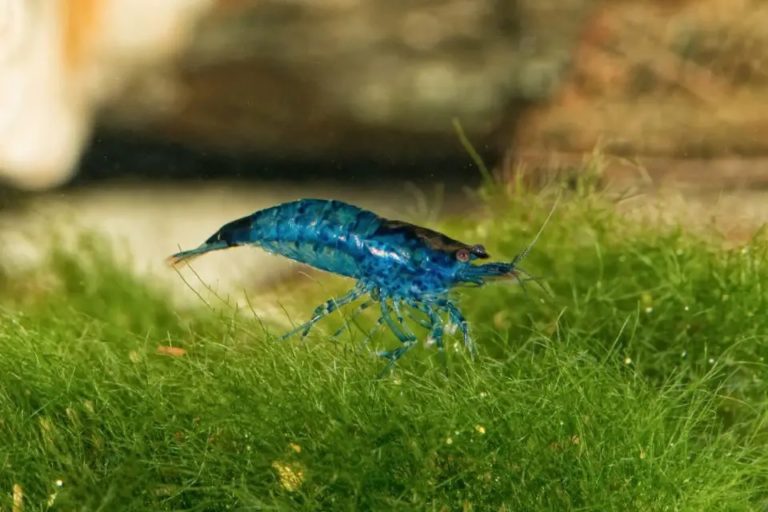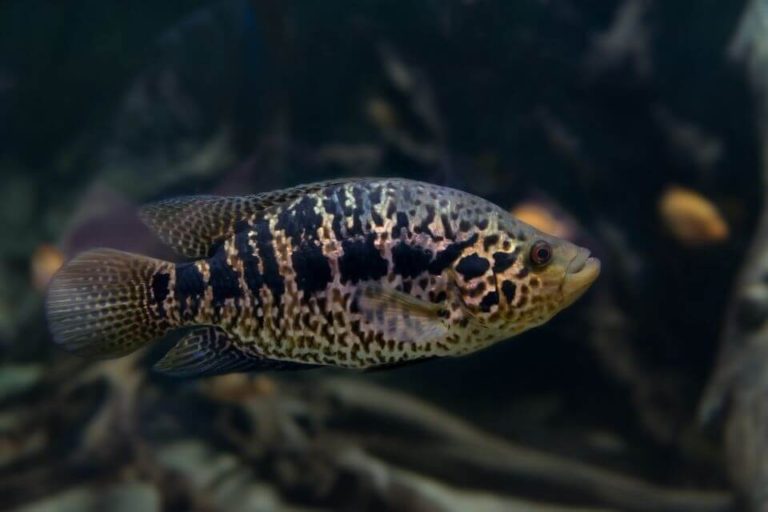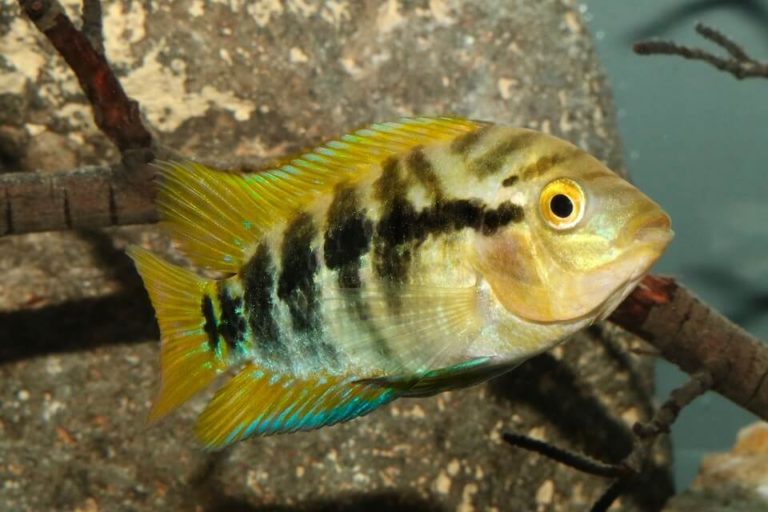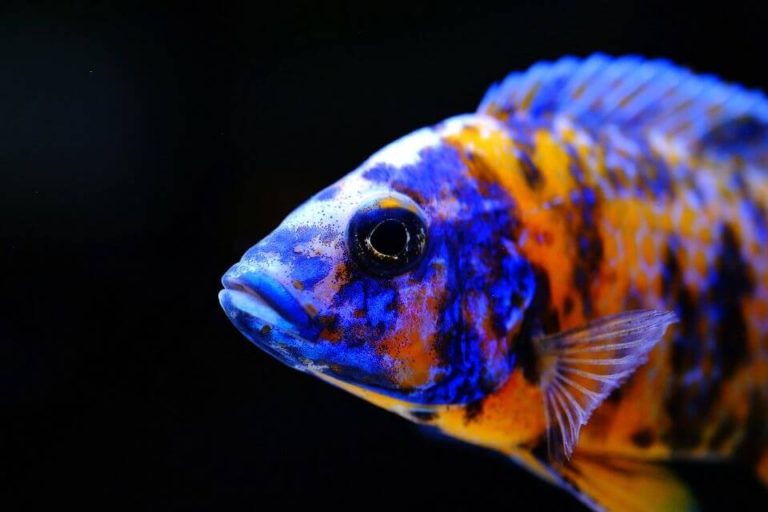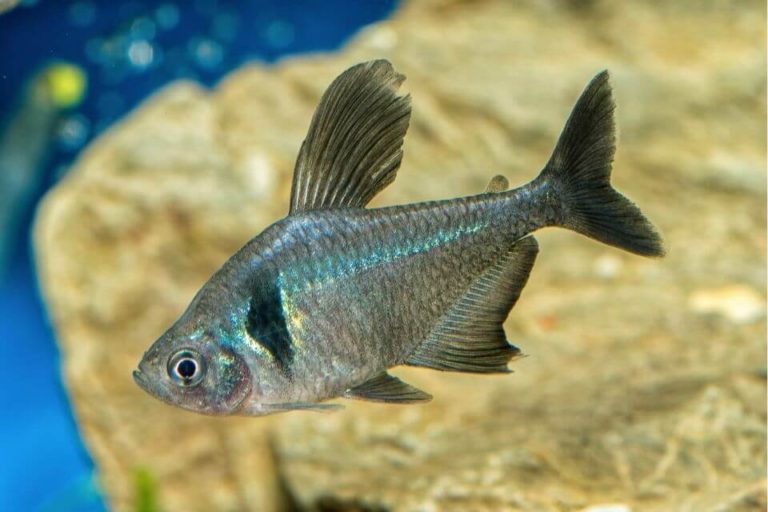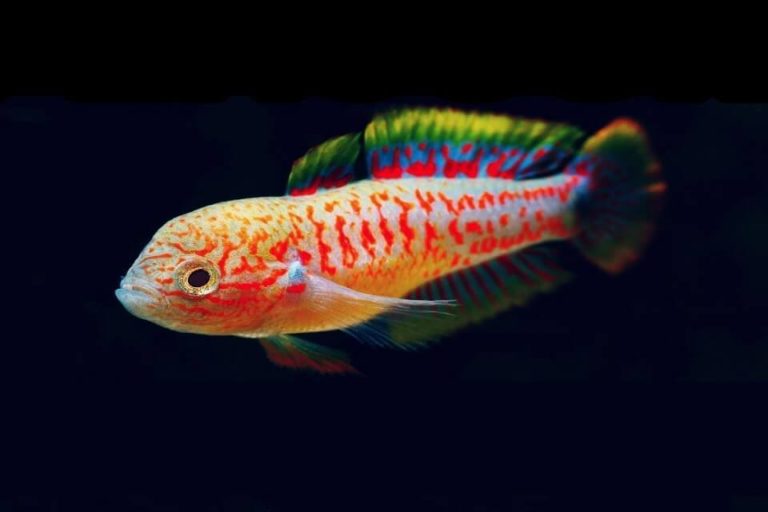Red Tail Shark Care Guide: Tank Size, Tank Mates and Feeding
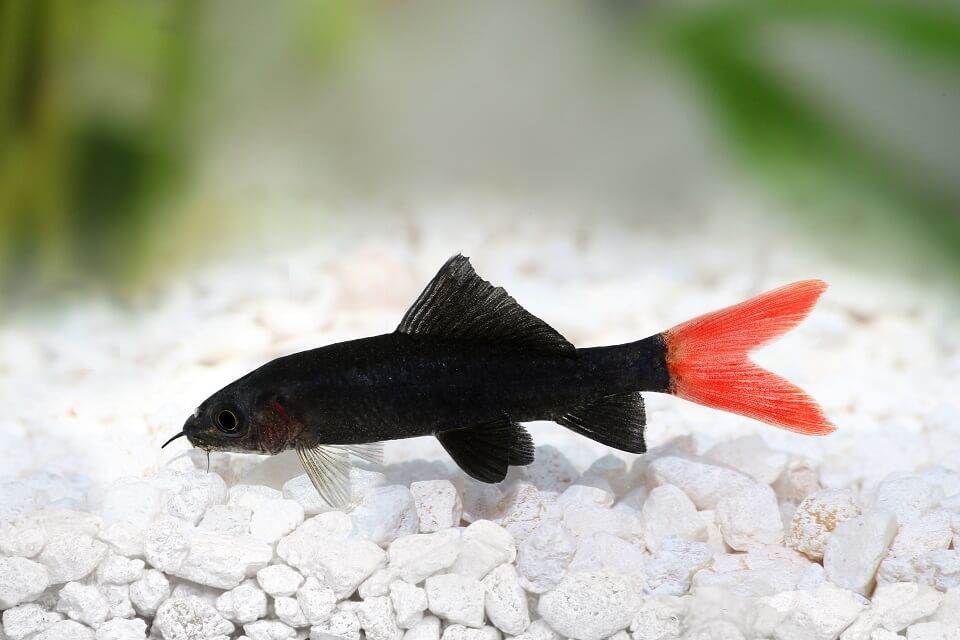
Red Tail Shark has eye-catching features that will brighten your freshwater tank or office aesthetic and keep you entertained with their aggressive behavior.
In the past few decades, their popularity has soared; thus, the reason they are on the list of endangered species.
The upside of keeping these fish is that they are easy to take care of, and as long as you provide them with the right habitat, they will live for 6 or more years. Continue reading to find out how you should take care of this fish species.
| Quick Facts: | |
|---|---|
| Common Names | : Red Tail Shark, Red-tailed Black Shark, Red Tail Black Shark, Redtail Sharkminnow |
| Scientific Name | : Epalzeorhynchos Bicolor |
| Family | : Cyprinidae family |
| Origin | : Chao Phraya River basin, Thailand |
| Care Level | : Moderate |
| Lifespan | : 4 to 6 years |
| Size (average) | : Up to 6 in (15 cm) long |
| Diet | : Omnivore eater |
| Breeding | : Egglayer |
| Social | : Territorial |
| Temperament | : Semi-aggrasive |
| Minimum Tank Size | : 55+ Gallons |
| Temperature | : 72°F – 79°F (22°C – 26°C) |
| Water Hardness | : 5 - 15 dGH |
| Water pH Level | : 6 - 7.5 |
Overview Of Red Tail Shark.
Red Tail Shark is scientifically known as Epalzeorhynchos Bicolor (or Labeo Bicolor). This stunning fish is also referred to as Red-tailed Black Shark, Red Tail Black Shark, Fire Tail, Redtail Sharkminnow, and Red Tailed Labeo.
These aggressive and stunning fish species are from the Cyprinidae family. They are freshwater species and thrive in fast-moving water bodies such as rivers and streams in Thailand.
Their natural habitat is also made of aquarium logs, driftwood, caves, and aquarium plants, which serve as hideouts and breeding grounds.
Because of excessive poaching, Red Tail Sharks are believed to be extinct in the wild. However, they are bred privately in large numbers and sold in the aquarium market.
Red-tailed Black Sharks are quite aggressive and territorial, and they cannot live with other Red-tailed sharks, making them a lonely fish species.
They have a 4 to 6 years lifespan, but some believed that they live up to 8 years with good care and optimal tank conditions. They are easy to take care of; however, their aggressive and territorial natures make it hard to have tankmates.
Therefore, select tank mates that can withstand their behavior.
Origin, Distribution, And Availability
Red Tail Shark was initially found in the floodplains and Chao Phraya River basin, in Thailand. However, because of excessive poaching, this fish species is believed to have become extinct.
This vibrant fish is now bred in private commercial facilities and made available in the aquarium market across the globe.
Because of its stunning appearance and dynamic nature, Red-tailed Black Sharks’ popularity among fish keepers is soaring. Redtail Sharkminnow is omnivorous and territorial; thus, it should be housed in large aquariums.
You can find Red Tail Sharks in your local fish store, or you can buy them online from trusted vendors and have them delivered right to your doorstep.
When buying this fish species, look for healthy signs, such as suitable color, powerful swimmer, good fin, and non-distressed breathing.
Red Tail Shark Typical Behavior
Red Tail Sharks are very active and fun to watch. When choosing tank mates for this vibrant species, go with the ones that are semi-aggressive. Why? Because Redtail Sharkminnows are pretty aggressive and territorial.
When they are young, they are relatively timid. Therefore, ensure that your tank has a lot of plants, artificial caves, and logs to provide them with hiding places. These places will also serve as hiding places for other fish.
The tank space determines Fire Tail’s behavior; the more room, the less likely your fish will be fixated on their tank mates. Therefore, ensure that your tank is spacious enough to accommodate Red Tail Shark and tank mates.
Red Tail Shark is always active, and you will find it swimming from the bottom to the top section of the tank. Although they will not bite their tank mates, they will hound them to the point of exhaustion.
Characteristics, Appearance, Color, And Size
Characteristics
In general, Red Tail Sharks have a lifespan of 4 to 6 years. Some aquarists reported that these species could live up to 8 years under optimal aquarium conditions and care.
Therefore, please provide them with living conditions that mimic their natural habitats, such as fast-flowing water, rocky substrate, optimal water conditions, and diet.
They are known for their color, aggressiveness, and inability to co-share space with another Red-Tailed shark. They do not move into a school, making them a lonely species. Therefore, if your tank is not spacious enough, do not add another fish of the same kind.
Appearance, Colors, And Special Markings

You will notice the Red Tail shark has two colors, black and red, creating a beautiful contrast to this fascinating species. The body of the Redtail Sharkminnow is black, while its tail or caudal fin is red.
This color combination brings it a unique appearance that makes your aquarium colorful. This fish standouts in the water because of its deep black body contrasted by the red forked tail.
Although it’s not the case for all Red-Tailed sharks, some have a caudal fin that is a little more translucent near the end. When this fish is stressed, the caudal fin fades in color.
Red Tail Shark Minnow has a long slim body flattened on both sides, with a curved back, taking on a torpedo shape. The fish has red eyes, and its mouth has two pairs of barbs.
Redtail Sharkminnows’ dorsal fin begins halfway through the body, and it’s the one you see in the movies that emerge on top of the water.
It is hard to distinguish between the male and female Red Tail Sharks when they are young, but as they mature, you notice that the female’s abdomen is fatter and rounded.
Average Size
Red Tail Shark is probably the most stunning fish in the aquarium market today. This vibrant fish can grow up to 6 inches under optimal care, with the smallest being around 4 inches.
But It is rare to find an aquarist with a Redtail Sharkminnow under 5 inches when it is fully grown.
Red Tail Sharks Habitat, Tank Conditions, and Care.
Habitat And Care
Red Tail Shark is a freshwater fish found in the algae ponds of Thailand. They are mostly found at the bottom part of freshwater floodplains, streams, and rivers, especially during the rainy season. It is a very active fish, and you will find it swimming around the tank.
This feisty fish is listed as a critically endangered species in its natural habitat. Because of poaching and industrial-grade farming, the Red-tailed Black Shark is believed to be extinct.
However, this species is bred in private and made available to aquarists in different parts of the world. Many people assume that because of their aggressive nature, Red Tail Sharks are hard to look after.
However, that is not the case. Although they are feisty, they are relatively easy to care for. You only need to know the basics, which is the case for every other aquarium fish.
Red Tail Sharks are hardy and can survive in a range of water conditions, making it easy for aquarists. However, you will have a problem on your hands if you provide them with insufficient tank space.
Tank Size And Tank Set-up

Because they are aggressive and territorial, ensure that you place them in gigantic tanks. Young or juvenile Red Tail Sharks should be placed in at least 29 gallons tanks, while adults should be placed in at least 55+ gallons tanks.
A good-sized tank ensures they have enough room to swim and reduces the likelihood of aggressive behavior toward their tank mates. You will also provide the fish with enough aquarium plants, caves, and hollow logs that act as hideouts.
Red Tail Sharks are famous in the aquarium world because of their beautiful and contrasting body, not forgetting they are easy to care for.
If you want to enjoy this feisty and vibrant fish from the comfort of your home or office, you can think of setting up a freshwater aquarium.
It is easy to set up an aquarium for Red-tailed Black Sharks if you follow along with this guide. You need to set up a freshwater tank by replicating similar conditions as the natural habitat of lakes and swamps found in Thailand.
Below we are provided you with the process that you need to follow in setting up your Red Tail Shark aquarium.
Tank Setting Up Process
- As I mentioned above, Red Tail Sharks are very aggressive and territorial. Therefore, ensure that the tank is spacious enough to accommodate them together with their tank mates. For instance, a juvenile Red-tailed Black Shark needs a tank of at least 29 gallons, while an adult tank should be at least 55 gallons. The tank should be low and long.
- The bottom of your tank should be filled with the substrate, and the most perfect is a rocky and gravel substrate. Also, include some artificial caves, driftwood, and hollow logs. To provide your fish with extra air, you can also include air stones or air curtains in the substrate.
- Install a good aquarium filter in your tank to provide your fish with safe, clean water. The filter eliminates waste, particles, and chemicals from your tank.
- Put water in your tank up to the top and leave one or two inches. You can use a hose or a bucket.
- Ensure that your tank is outfitted with a lighting system; the best is medium to low. They are nocturnal; therefore, if you want to view them during the day, move the tank to the darker side.
- Introduce aquarium plants in your tank. Ensure the plant is light tolerant. Also, make sure that they are fast or slow-growing light-tolerant aquarium plants.
- Leave your water on for a few days to check that the tank is operating smoothly.
- Then check the water pH, hardness, nitrates, and temperature. The water pH should range between 6 and 7.5 and the temperature should range between 72 to 79 degrees Fahrenheit, water hardness should be between 6 to 15 dGH, and zero nitrates. The kits for these tests are available at your nearest pet store, or you can buy them online.
- After making sure that the filtration and lighting system are working correctly and the water conditions are perfect, slowly introduce your Red Tail Shark into your aquarium tank.
- Add a weighted lid on your tank as Redtail Sharkminnow has the propensity to jump.
NOTE: Follow the instructions provided by the store. It is impossible to have a Red Tail Shark school. Therefore, keep one of these fish species in a tank. They're aggressive and territorial, making it challenging for males and females to stay together long enough to mate.
Suitable Plants
When putting up the tank, introduce live plants that are light tolerant. These include Microsorum and Anubias.
Water Temperature And Conditions
Water parameters are critical in ensuring the survival of your fish. So, make sure that the temperature is hovering between 72 and 78 degrees Fahrenheit, and the ideal water pH is 6 to 7.5.
Also, ensure that the tank water has a hardness rate of 5 to 15 dGH. This unique species of fish thrive in rapid flowing water, as it mimics their native habitat. Although they don’t have a unique filtration system, it is essential to install a filter.
A Canister or a Hang On Back filter will work best. Ensure that the filtration provides a sound filtration system for your tank and that it is durable.
Red Tail Sharks Diet And Feeding
Red Tail Sharks are omnivorous, meaning that anything edible in their way is food, especially in their natural habitat. From plants, crustaceans, worms, and insects.
They are also noted as scavengers as they feed dead fish, algae, and any food scraps found on the tank’s bottom.
This fish has a downward-facing mouth; that’s why you will find feeding on the food found in the substrate and other surfaces. Make sure that all the food you are feeding can reach the bottom part of the tank.
Why?
Because your shark will not leave the bottom and middle water to come to the topmost part of the tank for food. They will most likely wait for the food to drop at them.
It is recommended that you feed your sharks at least once a day. Provide your sharks with various healthy food such as live, frozen, dry, and branched vegetables. This ensures that your fish stays healthy and its’ color is maintained.
This fish species enjoy feeding on vegetable matter; that is why you will find it snacking on algae and live plants. Other vegetables to feed your sharks include Cucumber, Zucchini, and Shelled peas.
Wash all the vegetables before placing them in the aquarium and remove any uneaten greens after 24 Hours to avoid rotting.
Frozen food includes Brine shrimp, Bloodworms, Shrimp eggs, and frozen daphnia. You can also feed them insect larvae, fish flakes, and algae wafers.
Since it is challenging to find a trusted and consistent live shark food supplier, many aquarists prefer to cultivate their food.
Although Red Tail Shark feeds on algae, you should not depend on them solely to control algae growth. This is because a single fish cannot independently handle this problem. Instead, find an alternative or introduce tank mates that can help.
Red Tail Shark Diseases
They do not have a specific disease that affects them, but they can be affected by water-borne pathogens like other fish species. If the tail changes color, your water has contaminants, such as ammonia, nitrate, and nitrite.
The fin fades, taking a charcoal grey with a pinkish hue. Do a water change when you notice these signs.
Another disease that can affect your Sharks is Ich, also known as white spot disease and Fin Rot. This manifests as white dots on the fins. It is preventable by maintaining the right water conditions.
You should also isolate the fish that show signs of sickness to prevent spreading over other tank mates.
Gender Differences Of Red Tail Sharks
It is difficult to tell apart male and female Red Tail Sharks when they are juveniles. However, when they are mature, you can quickly identify a female shark with fat and a well-rounded abdomen.
And its dorsal fin’s posterior edge forms a right angle with her body. A male Red-tailed Black Shark has a curved dorsal fin with a sharper point at the top.
Breeding The Red Tail Shark
While it is easy to take care of this vibrant fish species, it is impossible to breed it at your home aquarium. This is attributed to their aggressive nature and their lack of tolerance for each other.
When the female Red-tailed Black Shark is ready to reproduce, its abdomen becomes fatter and rounded. This is the only feature that helps distinguish males and females.
Red-tailed Black Sharks are bred in commercial facilities, which helps them from becoming extinct. The females are injected with hormones to induce mating.
After fertilization, the fish lays the eggs in caves, hatch after a few days, and shortly after, they start swimming.
Juvenile Red Tail Sharks have a light silvery color that slowly transitions to black as they mature. The shark’s tail gets its red color in about two months.
Red Tail Shark Tank Mates
Red Tail Sharks can be territorial and aggressive towards other fish, especially those that have a similar body shape and coloration. Therefore, it’s important to carefully consider tank mates before adding them to an aquarium with a Red Tail Shark.
Suitable tank mates for Red Tail Sharks include larger, peaceful fish that inhabit different areas of the tank. Some good options include:
- Angelfish
- Discus Fish
- Severums
- Corydoras Catfish
- Bristlenose Plecos
- Neon Tetras
- Cardinal Tetras
- Rainbowfish
- Gouramis
It’s important to note that Red Tail Sharks should not be kept with other members of their own species, as they can become aggressive towards each other.
Additionally, it’s generally not recommended to keep Red Tail Sharks with small, delicate, or slow-moving fish, as they may be seen as easy prey.
Overall, when choosing tank mates for a Red Tail Shark, it’s important to consider each species’ temperament, size, and activity level, and ensure that they are compatible with the shark’s behavior and needs.
Frequently Asked Questions
Are Tetras Aggressive?
Yes. These fish species are aggressive and territorial. Therefore, when choosing tank mates, select those semi-aggressive fish that live in the upper part of the tank.
Do Red Tail Sharks Eat Other Fish?
Yes. Being a scavenger, this fish eats everything that it comes across; therefore, if the tank mates are small, the chances of being eaten are high.
But Redtail Sharkminnow does not hound other fish in the tank to eat them. They chase other fish to stress and wear them out.
How Many Red Tail Sharks Should Be Kept Together?
You cannot keep more than one Red-tailed Black Shark in a 50 gallons tank as they cannot tolerate each other. However, if you want to keep several, you will need to add at least one tank space meter for every Red-tailed Black Shark you add.
And if you decide to add, you need to keep at least 5 of them. Why? Because having 5 eliminates the probability of one alpha dominating the other.
What Fish Are Compatible With Red Tail Sharks?
Red Tail Sharks are aggressive and territorial, but this does not mean that they cannot be housed with other fish. This fish species become hostile only when they feel that its territory is being encroached upon.
Although it will not harass other fish, it will chase them relentlessly to the point of exhaustion, leading to death or malnutrition.
Their aggressive and territorial behavior makes it challenging to keep this shark species in a community tank–though still possible. Be careful when selecting tank mates.
Ensure that they are fast and strong, and spend most of their time at the middle or top-level part of the tank.
This is because Red-tailed Black Shark spends their time at the bottom part of your tank, ensuring that they will not cross paths.
Fish that can be excellent Tank mates with Redtail Sharkminnow include Tetras, Gourami, Angelfish, and Barbs. Some fish you should avoid are fellow sharks and those with large spots or red colors, as they will make your shark feel territorial.
Also, avoid docile and peaceful fish because they will feel threatened by Red Tail Shark.
What Is The Difference Between Red Tail Shark And Rainbow Shark?
It is not a wonder to find people confusing the two fish species. However, they are not the same as they have irrefutable differences, as discussed below.
Red Tail Sharks
- Only the tail is red, while the rest of their body is black with no other colors or markings.
- They stay at the bottom and the middle part of the tank. You will find them at the top when feeding only.
- They thrive in rapidly moving water. That is why you find them in fast-moving water, such as rivers and streams.
Rainbow Sharks
- All its fins are red, and the body is black or silver-black in some species.
- There is an Albino variety of Rainbow Sharks. It has a pale white body, and its fin’s color ranges from red to orange.
- Compared to Red-tailed Black Sharks, Rainbow Sharks are better at eating algae.
- They like warmer temperatures. They can thrive in temperatures of up to 81 degrees Fahrenheit, but above that, it can be detrimental to their survival.
- Compared to Red Tail Shark, which prefers rocky or gravel substrate, the Rainbow shark prefers sand as a substrate. This is because the rocks or gravel may scratch the fish’s volatile skin.
- They linger more at the bottommost part of the tank.
- They thrive in moderately flowing water. This is because Rainbow Sharks originate in slow-moving rivers and streams.
Final Thoughts On Keeping A Red Tail Sharks
Red Tail Shark is a beautiful freshwater fish that is a favorite among aquarists because of its unique features and uncomplicated care requirements. The only tricky part in keeping these aquarium fish species is their aggressive and territorial nature.
If you are looking to keep Red-tailed Black Sharks in your freshwater aquarium, we believe this guide will provide you with all the information you need.
If you found something that we missed in this care guide about Red Tail Sharks, please write your comments below.
We are happy to share your experience and knowledge with the fishkeeping community. If you have any questions or concerns about these species, please contact us anytime.


